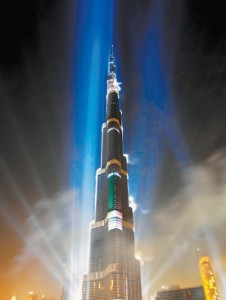By Kent Wolgamott www.journalstar.com
The world’s tallest building officially opened this month in the United Arab Emirates. At 2,717 feet – more than a half-mile – the Burj Khalifa towers over Dubai come closer than any other man-made structure to truly scraping the sky.

Judging by photos and video imagery, the Adrian Smith-designed tower is an impressive, graceful structure, getting narrower as it rises but still providing space for a hotel, retail, office and residential occupants.
Even though all of its apartments were presold and by some reports it has turned a profit, the Burj Khalifa is mostly empty. Such is the case for skyscrapers around the world.
But, as Los Angeles Times architecture critic Miles Edward Scott pointed out in a column marking the tower’s opening, emptiness extends beyond just big buildings constructed during the economic boom of the ’90s and ’00s.
It can be seen in vacant storefronts and abandoned developments in cities across the country and is reflected in popular culture, from television series about how the world would change if humans disappeared to apocalyptic/post-apocalyptic films like “2012,” “The Road” and “The Book of Eli.”
“This movement in the direction of emptiness is profoundly difficult for contemporary culture – and particularly American culture – to grapple with,” Scott wrote. “Occasional recessions and other setbacks aside, we assume that our national trajectory always moves toward fullness, that our cultural progress can be measured by how much new square footage we’ve created and occupied.”
Lincoln is far from Dubai, or Chicago or Los Angeles. But our little city is confronting urban emptiness as well.
Vacant office and retail space can be found here as in every other American city. Some of that emptiness can be attributed to ongoing changes in need and use, some to the slumping economy.
But the parallel with Los Angeles doesn’t stop there. In his piece, Scott pointed to parking lots that now occupy space where towers were supposed to be.
While on a smaller scale than the L.A. projects, Lincoln has its own “black hole,” a downtown block that was once envisioned to hold three skyscrapers.
To accommodate the proposed new buildings, the city took the land, then razed a pair of restaurants and a pair of multiscreen movie theaters. Like similar plans around the world, the $180 million Lincoln project vanished into the ether, a dream transformed into yellow-striped asphalt.
Now, those parking lots appear to be headed toward becoming a five-level parking garage topped with three floors of apartments and some street-level retail space. Total cost of the project: $27 million.
Beyond the easy observation that the first step down is a big one, the proposed development of that prime space raises some questions. Some are architectural; parking garages generally aren’t the most attractive buildings. Others have to do with the use of the space, particularly the retail component, which, one would hope, would be attuned to the area’s natural clientele of students, faculty and downtown workers.
Lincoln is now looking at nearly $1.7 billion in proposed projects in or near downtown, the only area of the city that can truly be called urban. They include a new arena, the University of Nebraska-Lincoln’s innovation/technology park on the former state fairgrounds and a Haymarket expansion of the Sheldon Museum of Art.
Whether any, all or none of the projects come to fruition remains to be seen. Each would have a far-reaching impact and would, to some measure, reverse the emptiness trend here. Even then, however, there’s likely to be some vacant spaces and lots here – and in every other city, even when you’ve got the newest tallest building in the world.
Reach L. Kent Wolgamott at 473-7244 or kwolgamott@journalstar.com.














